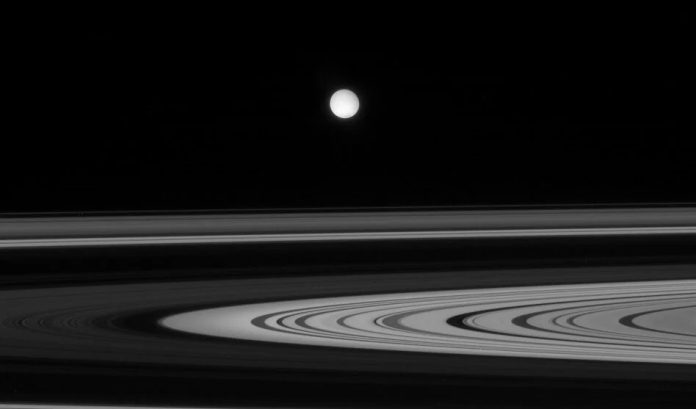
A small moon of Saturn named Enceladus is making waves in the scientific community as a top candidate for hosting life beyond Earth.
A study by Harvard University and NASA has uncovered exciting elements that are key to life’s building blocks.
This research, led by Harvard graduate student Jonah Peter, was recently published in Nature Astronomy.
Enceladus: A Moon with Potential for Life
Enceladus, covered in snow and ice, has been a point of interest for scientists, especially after the Cassini-Huygens mission revealed a giant plume of ice grains containing organic compounds.
The latest discovery in this journey is the detection of hydrogen cyanide within the water vapor shooting from Enceladus’s surface. Hydrogen cyanide, despite being poisonous, is an essential molecule for the origin of life.
The Role of Hydrogen Cyanide Jonah Peter and his team, including researchers Tom Nordheim and Kevin Hand from NASA’s Jet Propulsion Laboratory, explain that hydrogen cyanide is crucial for creating amino acids.
These are the building blocks of life, and hydrogen cyanide’s versatility in forming these compounds is remarkable. The study even likens hydrogen cyanide to a “Swiss army knife” for making amino acids.
Enceladus’s Hidden Ocean and Chemical Energy
Beneath its icy shell, Enceladus harbors an ocean that feeds the plume. This ocean is not just a body of water; it contains several organic compounds. Some of these compounds are similar to those that serve as fuel for life on Earth. This discovery indicates that Enceladus has more than just the basic requirements for life. It suggests complex biochemical processes could potentially support life in its subsurface ocean.
Life-Sustaining Chemistry
In 2017, scientists found chemistry in Enceladus’s ocean that hinted at the possibility of life.
The presence of carbon dioxide, methane, and hydrogen suggested a process called methanogenesis. This process, where microbes produce methane, is widespread on Earth and might have been vital for the origin of life here.
Jonah Peter’s recent work goes further. It shows additional energy sources in Enceladus’s ocean, suggesting diverse chemical pathways that could sustain life. These pathways are indicated by the presence of oxidized organic compounds. Oxidation is important as it helps release chemical energy, a key element for life.
The Future of Enceladus Research
While we are still far from proving life can exist on Enceladus, this research opens up new possibilities.
It lays out potential chemical processes that could support life, processes that can be explored further in laboratory settings.
This groundbreaking study, supported by NASA, brings us a step closer to understanding if life could emerge in environments beyond Earth, like on the intriguing moon of Enceladus.



